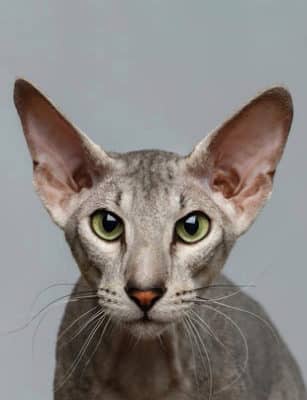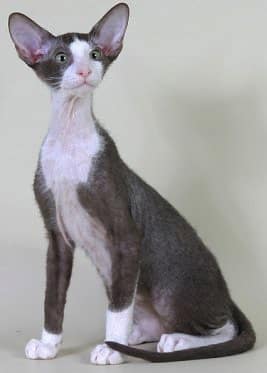Peterbald

Peterbalds are more friendly and sociable than their congeners – the Don Sphynx and Oriental cats. They are incredibly affectionate and playful, great with people. Find a common language with other cats and even dogs. Play with other animals and small children should be controlled because the open skin makes the Peterbald very sensitive and susceptible to scratches and cuts.
Table of Contents
Breed Information
| Origin | Russia |
| Size | Males 23-30 cm Females 20-25 cm |
| Weight | Males 4-5 kg Females 3-3.8 kg |
| Fur Type | Short-haired, hairless |
| Color | Oriental types of colors (chocolate, red, blue, black, tortoiseshell, cream colors), colorpoint (blue, chocolate, red, cream, and other shades) |
| Lifestyle | Indoors |
| Lifespan | 13-15 years |
| FIFe Classification | Category IV: “Oriental” Breed designation – PEB |
| WCF Classification | Group 4: “Siamese Oriental Shorthair” Breed designation – PBD |
| TICA Classification | PD |
| Group | Hairless (bald) cats, short-haired cats, cats for kids, cats for apartments (docile cats) |
| Price | $2000 |
Breed Photos
Origin History
Peterbald cat breed was bred in one of the cities of Russia – St. Petersburg. It happened at the end of 1994 due to experimental cross-breeding of Don Sphynx female and oriental short-haired male. This breed’s representatives, which are also called Saint-Petersburg sphynxes, can be entirely bald or with short hair. For this reason, Peterbalds with straight hair are sometimes mistaken for Siamese cats and completely hairless for sphynx cats. Still, the Peterbald is genetically a separate breed.
The Peterbald breed was recognized and allowed to participate in championship competitions by the International Cat Association in 1997 and by the American Cat Fanciers Association in 2008. Today, the Peterbald breed is considered a relatively rare purebred or purebred domestic cat breed.
Appearance
The peculiarity of the Peterbald cat breed is a different type of hair. The coat of the Peterbald can vary from velvety fluffy to its complete absence. There are a total of five different types. Even an “ultra bald” type of breed is characterized by the absence of a mustache or eyebrows and is sticky to the touch skin. There are cases where some cats’ fur changes significantly during the first two years of life – the cat may lose some of its hair or, conversely, gain it.
Oriental types of colors or colorpoint characterize this breed. Cats owners of Oriental colors can have chocolate, red, blue, black, tortoiseshell, and cream colors. Coat representatives of the breed with colorpoint can be blue, chocolate, red, cream, and other shades.
Peterbalds are very refined cats that have a long body type and an elongated head. A unique feature of Peterbalds is that they have long limbs and long forefingers, which allow them to hold toys and other objects. The eyes of Peterbalds are almond-shaped, slightly oblique. The color of the eyes is predominantly green, but in colorpoint cats, they can also be blue. The tail of a Peterbald is long and thin, pointed at the tip.
Character
Peterbalds are more friendly and sociable than their congeners – the Don Sphynx and Oriental cats. They are incredibly affectionate and playful, great with people. Find a common language with other cats and even dogs. Play with other animals and small children should be controlled because the open skin makes the Peterbald very sensitive and susceptible to scratches and cuts. And if such incidents occur, they should be disinfected and cleaned. Peterbalds are excellent house cats; they will happily climb onto their owner’s lap and can lie there for hours.
Peterbalds are very vulnerable; they don’t like to be alone and need companionship from others. These cats can spend hours watching the members of the family they live in while they go about their business. They don’t want to be alone in the house. Sometimes the representatives of this breed can be in a bad mood, and in these cases, it is better not to disturb them and do not try to cheer them up. You need to give them time, and the bad mood will be replaced by a good one.
Care
Caring for the Peterbald, in general, cannot be called complicated, but still, the owners of this cat will have to have some knowledge to provide their pet with the necessary conditions. The first thing to know is that representatives of this breed do not feel well at extreme temperatures. It is necessary to make sure that the Peterbald is not too cold – walks outside in winter are not recommended. Similarly, you must exclude direct sunlight on the cat. For these reasons, the Peterbald should always remain a house cat.
Taking care of a Peterbald’s fur or skin does not require much effort. If the cat has hair, it should be brushed periodically with a special soft brush. If it has bald spots or is completely bald, a weekly bath is recommended.
Education
Peterbalds are quite energetic cats; they are independent and intelligent, although they rarely show it. They can easily be taught to respond to their nickname, to do simple tricks. Peterbalds are quite athletic and active; they are happy to participate in various games and activities. It is not difficult to train your pet to the litter box. But getting him accustomed to his sleeping place will take a long time because Peterbald is very fond of sleeping with family members.
Common Diseases
Peterbalds have very delicate skin and are therefore prone to melanomas. Therefore, you should not take this breed outdoors in sunny weather. If it is unavoidable, it is necessary to use sunscreen. Also, you should always make sure that any scratches or cuts are cleaned to prevent infection. Since the Peterbald is a relatively new breed, no hereditary diseases to which it might be prone have yet been identified. At the same time, there is a theory that these cats are predisposed to lung infections. But this theory has not been scientifically proven yet.
Nutrition
Feeding a Peterbald is not an easy task. Because this breed has an above-average metabolism, they need to be fed up to five times a day. These cats eat a lot with no sense of proportion. If left to their own devices, obesity is inevitable. Therefore, meals should be on a schedule; in no case can you leave a full bowl of food for the whole day. Feed the Peterbald can be dry food or natural products. Sometimes a mixed type of food is used, but veterinarians criticize this approach.
From natural foods, the Peterbald can be offered lean meat, cereals, vegetables, and fruits. The taboo for this breed is chocolate, canned vegetables, chips, and other unhealthy foods. This breed will not shy away from anything, so you need to keep all those foods behind closed doors.
 Turkish Angora
Turkish Angora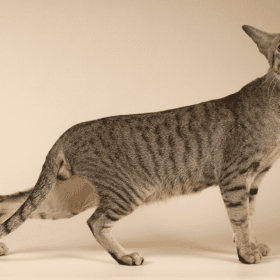 Oriental Shorthair
Oriental Shorthair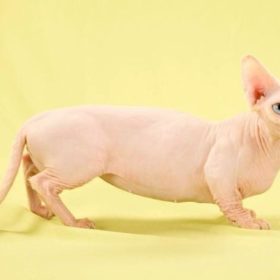 Minskin
Minskin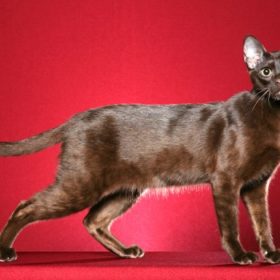 Havana Brown
Havana Brown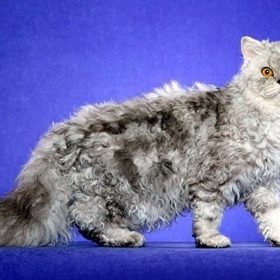 Selkirk Rex Longhair
Selkirk Rex Longhair Ural Rex Shorthair
Ural Rex Shorthair